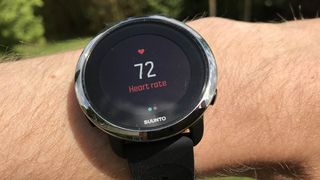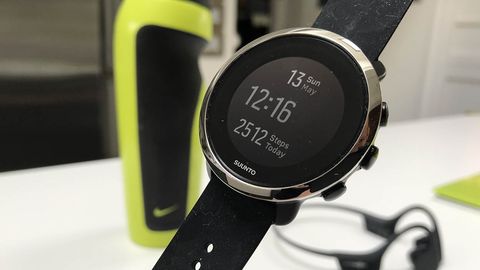Why you can trust TechRadar
Features and tracking
- Training plans adapt to your needs
- Can give real time feedback on how much strain you're under
- No GPS
The standout feature on the Suunto 3 Fitness is adaptive training. After an initial calibration (one run and one walk of 15 minutes with GPS connected) the watch uses estimated VO2 Max scores to assess your fitness levels and automatically generate a rolling 7-day training plan to help you improve your fitness.
The training plan adapts to your personal needs based on your profile, recorded exercises and fitness level and the aim is to improve your fitness gradually without over training and putting too much stress on the body. If you skip a session or do a little more than you’d planned, the 3 Fitness adapts your schedule accordingly.
While this makes it ideal for anyone who is just starting out, we thought the lack of any way to tell the watch what your overall objectives are, made it feel a little untethered. Most people need a goal that goes beyond ‘just get fitter’ to motivate them and that’s not addressed here.
What’s also quite strange is that Suunto hasn’t made a bigger deal about the initial calibration/fitness test when you first set up your watch. Considering this will form the basis of your training plans, we’d have liked a prompt to calibrate, instead we stumbled on the need to do this.

The sessions – and the adaptive analysis – are based very heavily on heart rate zones. The watch tells you when you’re working at the right intensity to hit the target for your sessions.
Unless you tell the Suunto app your maximum heart rate (there are various tests you can do to find yours), it will estimate it based on your age and gender. While this is common, it’s not the most accurate measure and so if you can we’d advise seeking out an alternate test to get this right. So many of the training features rely on this it’s quite crucial to be as accurate as possible.
In addition to the adaptive training plans, the Suunto 3 Fitness also provides a recovery time recommendation after each workout, based on how hard and how long you just trained, as well as your general overall fatigue.

The big omission here is GPS. That’s right, there’s no built in GPS on the Suunto 3 Fitness, instead the watch uses an accelerometer to calculate your running and walking speeds. Unless you run with your phone, in which case it’ll piggyback your phone’s GPS to provide distance and pace stats.
Another good but badly-explained feature on the Suunto 3 Fitness is Resources. A bit like some of the readiness measurements you can find on the Garmin Fenix 5, this gives you feedback on how much strain is on your body in real time.
During our tests we were suffering with a big cold and the watch picked up on this to show us we were under more stress than usual. That’s a really useful insight but again we had to research what this feature meant, it’s not made apparent on the watch or in the app itself.
When it comes to smartwatch features, Suunto basically offers a stream of notifications from your connected smartphone, you get everything from your phone, including emails, texts, Google Chat alerts, phone calls and more.
However there’s no subtlety here, you can’t tailor which apps you accept alerts from and after just 6 hours we found ourselves switching them off entirely to end the constant nagging and uncomfortable beeping in meetings.

Heart rate accuracy
- Erratic readings
- Post workout picture seemed broadly accurate
Many of the features on the Suunto 3 Fitness revolve around heart rate and so accuracy here is essential. The sensor is provided by Valencell Inc, one of the best in the game, so that’s a great start.
We tested the Suunto 3 Fitness up against the Apple Watch 3 with optical wrist sensor and a Polar H10 chest strap and we found the Suunto to be a little erratic.
At rest, more often than not it read 15 beats per minute higher than the Apple Watch and took far longer to stabilize. One strange quirk of the Suunto’s instant heart rate tracking was that every time we raised our wrist to check it, it initially read 72 BPM before slowly dropping to what we know to be correct, closer to 50 BPM.
During workouts we also found there was a bit of a lag between what we were seeing on the Suunto and our other devices, though the overall picture post workout followed a similar pattern.

Sleep tracking
- Sleep tracking seems accurate if limited
- Gives you a sleep quality score from 0 to 100
The importance of good quality sleep to achieving any fitness goal is now widely recognized. Bad sleep can derail even the most motivated people and well laid plans. So the addition of sleep tracking on the Suunto 3 Fitness is a win, even though it’s fairly basic.
That is, of course, if you can get over the idea of wearing a watch that’s not entirely comfortable, to bed. Let’s pretend you’re okay with that for a second.
The Suunto asks you to load in your normal bedtime routine, setting your sleep and wake up times. During this window it then uses the accelerometer to spot movement and follows your heart rate variability during sleep to assess the quality of your sleep.
The variation is an indication of how well your sleep is helping you rest and recover. Sleep quality is then displayed on a scale from 0 to 100 in the sleep summary, with 100 being the best quality.
We found the sleep tracking to be accurate, in as much as the total sleep time seemed to match what happened in the real world. However, with no feedback on the times you nod off or wake up, it’s hard to know whether it picked up the wake-up times 100% accurately.
This highlights some other quite significant limitations here too. It can’t automatically spot if you fall asleep earlier than your set bedtime, or in fact sleep longer than your wake time. These simply aren’t tracked unless you set your sleep window with hours either side as a catch-all.
Current page: Fitness
Prev Page Introduction, design and screen Next Page App, battery life and verdict
